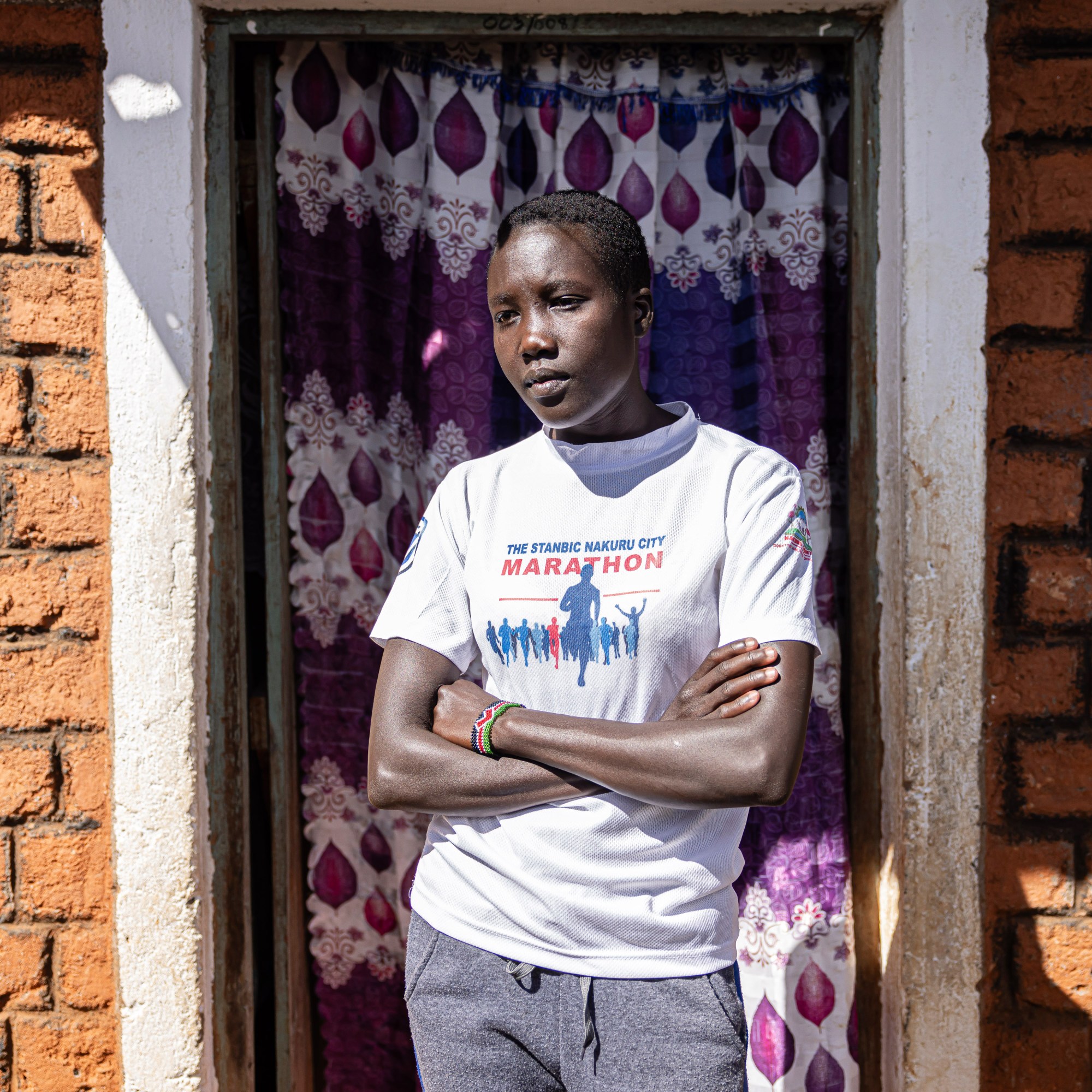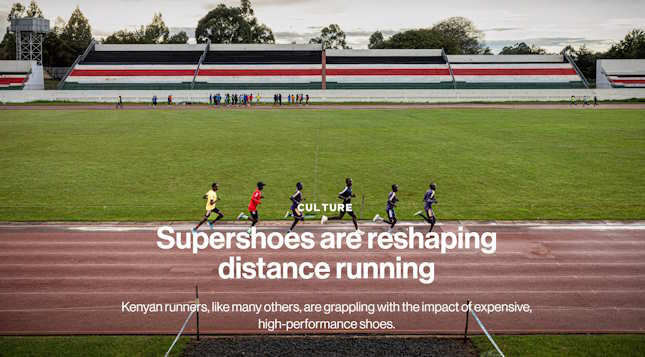Part 2 of 2. (Photo: Athletes train at Kipchoge Keino Stadium in Eldoret, Kenya. Credit: Patrick Meinhardt)
continuing from a previous article...
From talent to big business
While Kenya’s runners are renowned today for their marathoning dominance, the country first emerged on the global stage in track races. The watershed moment came at the 1968 Mexico City Olympics, where Kenya won eight medals in track and field, including gold in the men’s 1,500 meters, 10,000 meters, and 3,000-meter steeplechase. For the next two decades, the country’s athletes largely shied away from the marathon: according to Moses Tanui, a Kenyan who won the Boston Marathon twice in the 1990s, many men believed the event would prevent them from fathering children. Eventually, though, as money shifted away from the track and toward the roads, the longer distance had greater allure. Today, the winner of a major race like Boston can expect a several-hundred-thousand-dollar payday, between appearance fees, prize money, and shoe-company bonuses. As of May, according to World Athletics, Kenya-born athletes accounted for 28 of the event’s all-time 50 fastest men and 17 of its 50 fastest women.
Kenya’s outsize success is also closely linked to the concept of running economy. Studies of the Kalenjin, a community of nine closely related tribes that produce the majority of Kenya’s top athletes, point to several physical attributes more common in this group that are conducive to an energy-efficient gait, including thin lower legs, long Achilles tendons, and a high ratio of leg length to torso. Active childhoods in the highlands to the west of the Great Rift Valley, where altitudes between 6,000 and 9,000 feet help boost aerobic capacity, is likely a component of their success as well. It’s the prospect of financial rewards, though, that drives participation—and transforms raw talent into records. Although Kenya is one of Africa’s most industrialized countries, even top university graduates struggle to find well-paid jobs. In the villages and small towns of the Rift Valley region, where economic prospects are especially limited, many are drawn to running by default. “After high school, if you don’t continue with your studies, you can run or you can be idle,” says Brigid Kosgei, a Kenyan who held the women’s marathon world record before Assefa. “So you run—you try your best.”
It is in this context that the stakes of shoe technology are so high: in top competitions, places worth tens of thousands of dollars—representing new homes for parents and school fees for children—can come down to seconds. For a few years after Nike’s release of the Vaporfly, the odds were stacked against runners sponsored by other companies, whose contracts prevented them from using competitors’ products. The gap was partly psychological: Cyprian Kotut, an Adidas-sponsored runner who’s won marathons in Paris and Hamburg, recalls feeling disillusioned mid-race next to Nike-shod competitors. Some sought out workarounds. One cobbler in Ethiopia gained fame for his skill in attaching Vaporfly soles to Adidas uppers—thereby helping some Adidas runners stealthily utilize the Nike tech.
“After high school, if you don’t continue with your studies, you can run or you can be idle … So you run—you try your best.”
Brigid Kosgei, Kenyan who held the women’s marathon world record
Today, the playing field is far more level—at least among established pros. At the 2 Running Club, an Adidas-sponsored camp set amid rolling tea fields south of Eldoret, Kotut and his teammates give me a glimpse of their Adizero carbon-fiber lineup. There’s the ultra-padded Prime X for long sessions on pavement; the more compact Takumi Sen for speedwork; one pair of the featherlight black-and-white Evo, which Kotut used to run a personal best of 2:04:34 last year in Amsterdam. Claudio Berardelli, the group’s Italian coach, estimates that his runners cover at least 60% of their mileage in supershoes. For most, they’ve become as vital to training as they have to racing. Not only do they enable faster workouts, says Benson Kipruto, a club member who won the Tokyo Marathon in March and finished second to Kiptum in Chicago last fall; the softer foams also promote quicker recovery—to the point where the day after a hard session, “your legs are a bit fresh.”
Many credit the shoes with keeping runners healthy. David Kirui, a physiotherapist who’s treated many of Kenya’s top marathoners, estimates that overuse-related injuries, like stress fractures, Achilles tendinitis, and iliotibial band syndrome, are down at least 25%. Several veteran runners tell me the shoes have helped extend their careers, and therefore their earning power. “In the old shoes, after 10 marathons you’d be completely exhausted,” says Jonathan Maiyo, who’s been an elite road racer since 2007. “Now 10 marathons are like nothing.”
Who benefits?
Runners like those in Berardelli’s group are a chosen few. The majority of athletes training in Kenya have never made any money from the sport; many run in secondhand shoes gifted by friends or purchased in local markets, and few can afford supershoes of their own. One day in Iten, a small town north of Eldoret that clings to the edge of the Rift Valley escarpment, I meet Daisy Kandie, a 23-year-old who moved here after high school and is among the hundreds of aspiring pros who toil along the town’s clay roads each morning. Her goal is the same as most: get noticed by an agent, most likely a foreigner, who’ll provide gear, arrange races outside the country, and in some cases negotiate a contract with a shoe company.
Among Iten’s legion of dreamers, Kandie is luckier than most: her parents see her as a future breadwinner, so they’ve supported her quest, and even sold a plot of farmland so they could buy her a pair of neon-green-and-pink Nike Alphaflys. The shoes were cheaper in Iten—approximately $180—than they would have been in the US; it’s an open secret that some runners with sponsorships sell shoes they get for free to local shops, which resell them at below-market prices. That money, nonetheless, represents a lot of sacrifice: Kandie pays roughly that amount for a year’s worth of rent on the small room she keeps at the edge of town. The cost of the shoes, which she refers to as her “Sub-2” for the idea of a below-two-hour marathon, doesn’t make her resentful. Instead, she says, having the latest gear helps keep her motivated. Still, while she uses them only for fast runs twice a week, as well as in occasional local races, their soles have considerable wear, and she doesn’t have a plan for a replacement.
“By then I’ll have gone,” she said, referring to racing outside Kenya, when I asked what she’ll do for her next pair. “I have hopes."

A sign welcomes travelers to Iten, a small town north of Eldoret that clings to the edge of the Rift Valley escarpment. PATRICK MEINHARDT
Although supershoe technology has raised the cost of doing business for Kandie and others like her, it’s most controversial for its role in skewing results at the very top. Hoogkamer’s landmark study of the Vaporfly, which found that the shoes improved running economy by 4% on average, also found that the benefit ranged from roughly 2% to 6% depending on the athlete.
Subsequent research involving other supershoes has documented a similar range of responses. One 2023 study by Adidas-affiliated researchers, which tested seven elite Kenyans in three carbon-fiber prototypes and a traditional racing flat, recorded a runner using 11% less energy in one shoe and a runner using 11% more energy in another. Melanie Knopp, the study’s lead author, cautions that each athlete was tested in each shoe only once, and that some of the subjects were unfamiliar with running on a treadmill. Nonetheless, researchers generally agree that individual athletes “respond” to some shoes better than others. Why isn’t entirely clear: Hoogkamer estimates there may be 20 variables at play, including weight, foot length, calf muscle strength, and whether the runner strikes the ground with the forefoot, midfoot, or heel. Shoe geometry matters as well. Abdi Nageeye, a Dutch marathoner who trains in Iten and finished second to Kipchoge at the Tokyo Olympics, says he struggled with the first two versions of Nike’s Alphafly; as a 120-pound heel-striker, it forced him to “skip” in a way that felt unnatural. He says the newest Alphafly model, which has a greater drop in “stack height”—or foam thickness—from heel to toe, is a much better fit.
“If everybody is in their ideal shoe, are there still some people who’ll get more benefit than others? The answer is probably yes.”
Dustin Joubert, a supershoe expert and professor of kinesiology at St. Edward’s University in Austin, Texas
What all this means for the marathon’s integrity is a hotly debated topic. Today, many pro runners in the West undergo treadmill-based metabolic tests to determine which shoe works best, and in some cases which company to sign with. That’s less common in Kenya, where greater competition leaves athletes less room to negotiate. Among runners I spoke with, most of those with shoe contracts said their sponsor has a model they like, but it’s difficult to know if it’s their absolute best fit. Even if it is, some suspect that certain runners are better suited to the supershoe technology more broadly. “If everybody is in their ideal shoe, are there still some people who’ll get more benefit than others?” asks Dustin Joubert, a supershoe expert and professor of kinesiology at St. Edward’s University in Austin, Texas. “The answer is probably yes."

Daisy Kandie’s Alphaflys cost $180 on the secondary market. She pays roughly that amount each year to rent a small room on the outskirts of Iten. PATRICK MEINHARDT
Despite the benefits his runners gain in training, Berardelli says the shoes have introduced “question marks”: in a marathon today, he says, it’s less clear than ever whether the winner is indeed the runner who’s the strongest or has the smartest racing tactics. Stephen Cherono, a Kenyan who competed for Qatar as Saif Saaeed Shaheen and held the world record in the 3,000-meter steeplechase from 2004 until it was broken with the aid of superspikes last year, believes World Athletics should have placed greater restrictions on the technology before it was too late: although the global body maintains limits on sole thickness and prohibits the use of shoes that aren’t made available for sale, these guidelines are meant to help steer innovation, not squelch it. Cherono tells me he’s a big fan of Formula 1, the global motor sport, but worries that running, in its focus on performance engineering, is becoming too much like it. “Too often the conversation is now about the shoe and not the person wearing it,” he says.
What might have been
If there’s one thing supershoe advocates and critics can agree upon, it’s that Kelvin Kiptum operated on another level. His margin of victory in Chicago—nearly three and a half minutes—was so large that some joked second-place Kipruto had won the race for mortals. Like most runners in Kenya, Kiptum grew up in a farming family where money was tight. When he began training as a teenager, he often ran barefoot; occasionally, pros he tagged along with gave him shoes. Among them was Hakizimana, a Rwandan who trained near Kiptum’s home and took him on as a protégé when his own running began to falter. After a stint training to be an electrician, Kiptum began running full-time in 2018; four years later, in his marathon debut, he ran the third-fastest time in history. Atypically, in all three of his marathons, he ran the second half faster than the first—perhaps because Nike’s PEBA foam had helped “save” his legs, or perhaps because his training was so grueling. Most world-class Kenyan marathoners top out around 220 kilometers per week. According to Hakizimana, Kiptum would often run up to 280, or roughly a marathon’s distance every day.

Kandie out for a run with friends in Iten. PATRICK MEINHARDT
One month to the day after I watched Kiptum circling the Eldoret track, completing 1,000-meter repeats at roughly the pace of a two-hour marathon, I gather with hundreds of others on a property he’d purchased outside town, where he is being buried according to Kalenjin tradition. The crowd again includes a who’s-who list of champions; this time, instead of running gear, they are dressed in suits or black T-shirts emblazoned with the record-holder’s image. Their mourning is both for a man who died far too young—Kiptum was listed as 24, though he was likely at least a few years older—and for a remarkable performance that many had expected to be just around the corner. Entering Chicago, Kiptum had been dealing with an injury and wasn’t even in top shape, according to his training partner Daniel Kemboi. Ahead of Rotterdam, Kemboi says, “he was so confident.” Very few in Eldoret doubted he would shatter the two-hour barrier.
At some point that afternoon, my mind drifts to the shoes. Kiptum had been an extraordinary competitor regardless of what was on his feet. Still, absent supershoe technology, the prospect of a sub-two-hour marathon would never have been part of his dramatic rags-to-riches story. In this sense, the shoes didn’t minimize his greatness, as critics like Cherono feared; if anything, they helped build his brand and turbocharged his pursuit of the Kenyan running dream—of achieving a better life through sport. Tragically, Kiptum’s path was cut short when he was only getting started. But someone else, in rigid shoes with bouncy soles, will come along to blaze their own.











